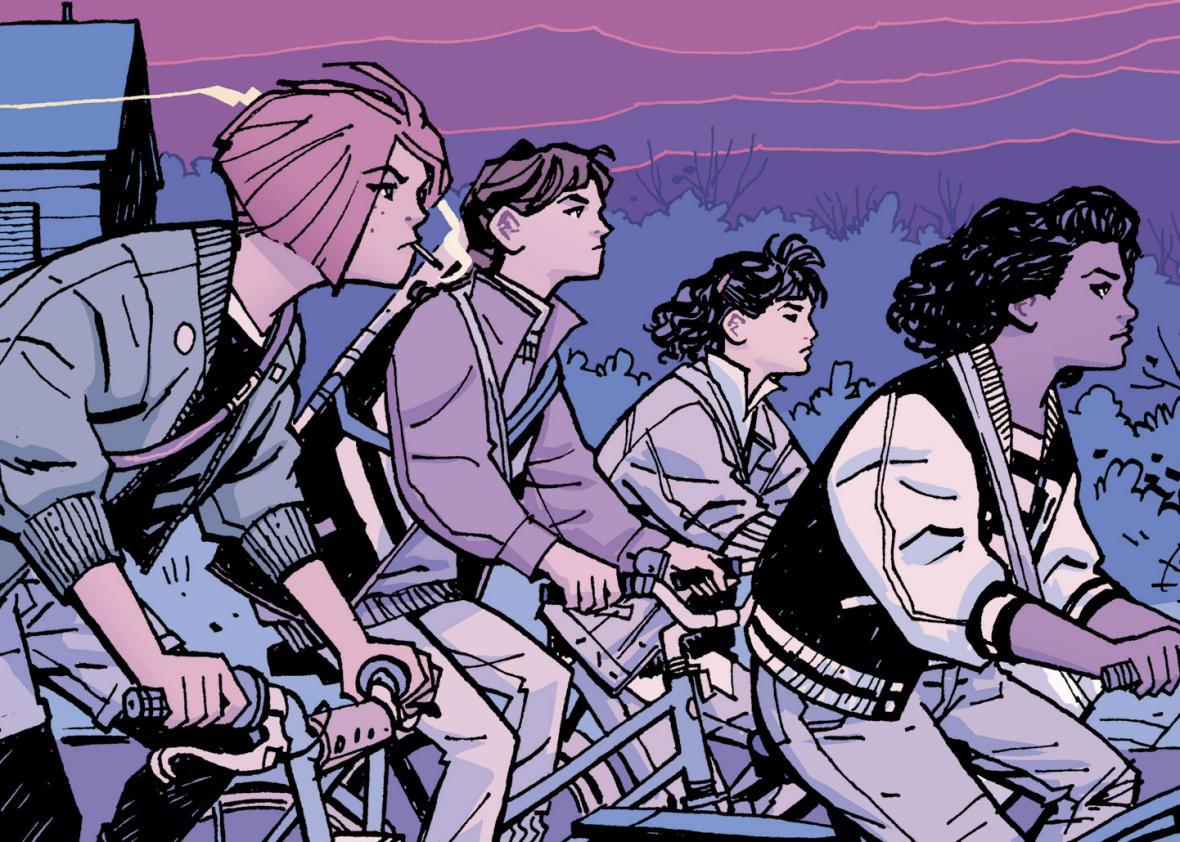In the wee hours of the morning after Halloween, 1988, a paper delivery girl named Erin sets out on her route in a sleepy Ohio town, autumn leaves crunching beneath the wheels of her bike as an odd red comet streaks through the sky. She soon encounters several older teenage boys dressed in lackluster monster costumes still milling through the neighborhood; within moments, they’ve gotten physically and even sexually aggressive. One of them grabs the handlebars of her bike, demanding a free paper, and refuses to let her leave.
That’s when the rest of the paper girl posse arrives, weapons like field hockey sticks slung across their backs. The ringleader of the boys tries his intimidation game again but falters under the crude insults and steely gaze of three tween girls named Mac, KJ, and Tiffany. He ultimately slinks away, tossing an impotent middle finger in their direction.
Meet the heroes of Paper Girls, a comic-book series created by star writer Brian K. Vaughan and artist Cliff Chiang that opens with a familiar premise: a nostalgia-rich story about coming of age in the 1980s. Except that instead of the boy heroes that typically dominate ’80s adventures, Paper Girls is centrally concerned with the lives and relationships of adolescent girls.

Image Comics
It’s an unfamiliar sight in a medium that has historically felt like one long failure of the Bechdel test, particularly in a mainstream title by an A-list creator like Vaughan. Having an adolescent girl as the star of a comic book—particularly one who isn’t sexualized—is unusual enough; having four preteens girls and their friendships with each other take center stage feels as rare a cosmic event as that red comet. But Paper Girls is part of a larger sea change in the way women and girls are treated in comics, both on the page and off. The recent Eisner Award nominations boasted a record 61 nods to female creators while last year every comic book creator who took home an Ignatz Award—a prize focused on small press work—was a woman. That’s not even to mention the hugely popular books by female cartoonists like Kate Beaton and Raina Telgemeier, whose work continues to dominate the New York Times graphic novel best-seller list.
Institutional change at Marvel and DC has been slower than the shifts in the indie scene, but the kinds of tone-deaf, objectifying portrayals of women that were once unremarkable are now routinely greeted by online backlash that has grown hard to ignore. Women in the comics industry are still underrepresented and routinely face hostility and harassment, but they are nonetheless more visible, more vocal, and more numerous than ever before.
Vaughan, who has also written for television shows like Lost and Under the Dome, is a prominent name in the comics world, thanks to his work on several very celebrated books that he co-created with women. He and artist Pia Guerra created Y: The Last Man, a best-selling comic that imagined an Earth populated entirely by women after a plague wiped out all men save one; more recently, he and artist Fiona Staples created Saga, an interspecies alien love story that tackled the trials of marriage and parenthood—and once became the target of controversy for depicting a breast-feeding baby on its cover. But Vaughan told me that he still felt his existing work hadn’t pushed the envelope far enough when it came to gender. In the aftermath of his success with Saga, he wanted to go further.
“I wanted to take a chance,” said Vaughan. “I’ve always enjoyed writing female characters, but sometimes it feels like even when they’re protagonists, they’re still defined by their relationships with male characters. I wanted to write about girls who could just be characters on their own, who weren’t defined by their interactions with men.”
Paper Girls evokes a similar thrill as many of the best kids’ films of the ’80s: Instead of looking at childhood through a rosy, sanitized lens, it makes being 12 feel exactly as dangerous and exciting as it truly is. There’s a frisson of excitement in the swear words and threats and unsupervised moments of childhood, a sense of being both invincible and intensely vulnerable. The story features smoking, swearing, and fighting, drunk step-parents, and a handgun that makes its way into the hands of our young protagonists. Mac and her friends aren’t “nice” girls, per se—or rather, they aren’t captive to the tyranny of niceness that so often constricts female characters, particularly young ones. Instead, they bristle and crackle with a transgressive spark, riding through the empty streets, smoking cigarettes, and chattering on walkie-talkies before the sun comes up. It’s a vision of adolescent freedom that feels both exhilarating and somewhat alien in the era of the helicopter parent. “We were this generation of latchkey kids,” said Vaughan. “We were the last generation, I think.”
In that first issue, as the girls cruise past through a pitch-perfect ’80s neighborhood holding brick-size Walkmen and passing “Bush ’88” campaign signs on nearby lawns, it feels like Paper Girls is shaping up as a simple slice-of-life period piece about four preteen girls in small town Ohio, a tougher, more dangerous Baby-Sitters Club.
That’s when the alien invasion begins.
Or at least that’s how it seems: Parents disappear into thin air, deformed figures wrapped in black bandages start lumbering through the streets, the skies fill with monsters, and the surface of time itself gets sliced into venetian blinds. The four girls are left to deal with this bewildering and terrifying new reality all on their own, without any adults who can offer them answers. The situation remains equally opaque to readers, and even by the end of the first story arc (out now in a paperback collection) it’s not entirely clear what’s going on, who the bad guys are, or even when certain events take place. According to Vaughan, that’s by design.
“You’re allowed to be confused now, but just know that we’re not. We know what we’re building to,” said Vaughan. “We wanted to simulate how it feels to be 12—you’re so hyper-attuned to what’s going on in the world, but you don’t have access to the knowledge of what’s really happening. I didn’t understand what was going on with the Cold War, but I knew there was a chance that we might all die. You feel very alive, but it’s also totally terrifying.”
Despite this focus on adolescent life in 1988, Paper Girls resists being a pure nostalgia-fest. (One issue opens with a line of alien text that translates as “NOSTALGIA IS DEATH.”) Rather than serving yet another fat slice of recycled childhood to thirty- and fortysomethings, it aims to be a book that either a 40-year-old or a 12-year-old could pick up and enjoy, and the retro setting feels crucial to this goal. “I always think of seeing Stand by Me with my dad,” said Vaughan. “That was a movie about people my dad’s age, set when they were 12. In some ways, it felt like, Oh, this is the ancient past, but it was also like, Whoa, these kids are exactly like me, things haven’t changed that much. I think being 12 is somewhat universal.”
If there’s one thing mainstream comic book readers are accustomed to, however, it’s seeing universal experiences reflected almost reflexively through male characters. Although it was created by an all-male team—and features mostly white characters—the delights of Paper Girls are still more evidence that the arc of change in comics is bending toward more diverse, better stories. Instead of pandering to the antiquated desires of male fans who prefer that their entertainment resemble a hall of mirrors, Paper Girls is a reminder of how fresh and accessible even the most familiar stories and tropes can feel when people who have been consigned to the sidelines of popular entertainment take center stage.
“Comic book readers are the most nostalgic people ever,” says Vaughan. Many of them “just want to keep reading what they were reading when they were 12. But there are some people who just love the medium and want to read something new.”
—-
Paper Girls by Brian K. Vaughan and Cliff Chiang. Image.
See all the pieces in the Slate Book Review.
